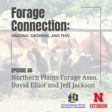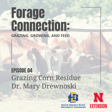Become a Creator today!Start creating today - Share your story with the world!
Start for free
00:00:00
00:00:01

Round Bale Storage: Dr. Kevin Shinners
We talk with Dr. Kevin Shinners, emeritus professor from the University of Wisconsin on how to produce and store round bales to minimize loss and maximize quality.
Transcript
Introduction to The Forage Connection
00:00:07
Speaker
It's The Forage Connection, racing, growing and feed with your hosts, Ben and Sarah. Today we're diving into all things round bales. Today we have really the local expert in hay and forage storage, I would say.
00:00:22
Speaker
Dr. Kevin Shinners, he's with the University of Wisconsin. Dr. Shinners is an Ag Engineer.
Expertise of Dr. Shinners
00:00:27
Speaker
He's currently an Emeritus Professor and he has spent much of his career focusing on the mechanical aspects of hay, forage, and biomass crops. I have heard Dr. Shinners speak several times and he does an excellent job of breaking down what we do and why we should or shouldn't do some of these practices. So I'm excited to talk with him today. I think we're
00:00:50
Speaker
Really glad, Dr. Shinners, you were willing to come with your emeritus status, being retired, willing to come and talk with us. So welcome. Thank you, Sarah. And thank you, Ben.
Effects of Baling on Storage
00:01:00
Speaker
This morning, we want to talk about round bale storage in general. But the big question as we get started is how does baling affect storage? There's so many different aspects of how to put up a good round bale. And where do we begin with this conversation, Dr. Shinners?
00:01:16
Speaker
Right, so when we think about trying to have good round bale storage, I always like to tell producers that it starts in the baling process. As soon as the baler hits the field, we need to think about some things that are going to affect the storage characteristics of those bales. One of those is the type of wrap that you're going to use on the bale, net wrap versus twine wrap. We'll kind of come back to that just in a second here, but I wanted to just mention to you that really what we're trying to do with a round bale is to help that bale
00:01:44
Speaker
shed water precipitation during an event and get that water drained away from the bale and really this to get that water to be shed off the bale we have to form a good thatch and it's the leaves of the plant that form the thatch. So in that baling process we are going to choose neither net wrap or twine wrap and when we hit use net wrap we're going to be rotating that bale maybe three to five times in the bale chamber before we have the wrapping process done and we can eject the bale
00:02:14
Speaker
Whereas with twine wrap, typically 20 to 30 rotations in the bale chamber that required to get that bale wrapped tightly with twine. And unfortunately, when we rotated that many times, we tend to knock off a lot of leaves. The leaves are forming the thatch. We've started to remove the positive aspects of those leaves being there. And we're going to have a thatch that's not going to be ideal. Net wrap is not only good from the standpoint of
00:02:45
Speaker
productivity, you can get the job done faster, but you're going to be able to save more leaves in the wrapping process, and that's going to help us with the thatch when we have that bale in storage. I also like to say that what we need to do is to form a really nice dense bale with a good shape.
Bale Density and Shape Importance
00:03:02
Speaker
A dense bale doesn't squat as much during the storage process, and when the bale squats, more of the bottom touches the ground, we're going to have more rejected hay.
00:03:12
Speaker
So a nice well-formed dense bale will do less squatting over time and will have less rejected hay from that bottom of the bale. You also want to make a nice, what I say, a square-shouldered bale. You want to drive over the windrow in such a way that you're pushing hay against the side walls of the bale chamber. That's what helps form a nice, tight shoulder on that bale, if you will.
00:03:39
Speaker
And of course, you want to use the driving aids and the monitor on the baler to help you get that bale chamber filled side to side uniformly. I've made many wedge-shaped bales. I've made many barrel-shaped bales. It's just one of the things you learn over time. But those are more difficult to get into a row or into a stack and form a good shape. So if you can make a really very cylindrical, square-shoulder, dense bale, that's going to be helpful as well. And of course, with net wrap,
00:04:09
Speaker
That's becoming more and more popular. You're seeing less and less twine wrap out there. So that's a good direction that we're heading in the business.
Bale Size Recommendations
00:04:19
Speaker
So we are really focusing initially on making sure that we get a bale that's ready and set for storage. We're looking at that wrap correctly. We want the right density. We want the right size bale to fit our equipment and everything. Once we get that bale formed, a lot of times we're storing these round bales outside.
00:04:36
Speaker
What are we looking at from a loss standpoint, Dr. Shinners? What are some characteristics? What are we looking at from that bale that we don't want to see happening, make sure that we're having that quality hay? I'm just going to swing back to one more thing about the baling process. I just want to mention to you that with a round baler, you can choose up to the largest diameter that the baler makes, but you want to try to make as big a diameter bale as you can.
00:05:03
Speaker
Because as the bale is going to weather, you're going to see a two to four inch weathered layer on the outside of the bale.
Storage Methods to Minimize Loss
00:05:10
Speaker
A six foot diameter bale that may be anywhere from 10% to 15% of the bale volume, where a five foot diameter bale, that's maybe 15% to 25% of the bale volume. So it makes a lot of sense to make as big a bale as you can, because you're going to have less volume of that bale is going to be exposed to the elements.
00:05:33
Speaker
Also, when you make a bigger diameter bale, you're going to have fewer bales to handle. And that can be very helpful from the productivity standpoint. Picking bales out of the field is what I say is never a value-added operation. And the fewer bales you've got to handle, the more cost effective you're going to be in your operation. So you asked about the storage process here. I think we'll talk first about wanting to make sure that you
00:06:03
Speaker
minimize the amount of precipitation that you get on the bale. And the best way that you can do that is going to be to store the bale under cover, under a tarp, or in plastic film, and enroll in plastic film. We're seeing more and more interest in wrapping bales with plastic film. That's a successful process for dry hay. If you manage it well, we have done a little bit of research on this, and it is, we found that if you get the bale,
00:06:33
Speaker
quite dry, 15, 16, 17% moisture content. It's more successful than if you have the bale at 18, 19, 20, 21% moisture content. When you have it at those little higher moisture contents, we tend to get some condensation on the outside of the bale between the interface between the bale and the film. That tends to create a little bit of a mold growth there. That can be some hay that's going to be rejected.
00:07:00
Speaker
Of course, there's also the cost of that you have to consider as well. If you have a relatively high quality hay, wrapping and film can be quite cost effective. If you have a lower quality hay, it's probably not a process that's going to be economically viable.
00:07:16
Speaker
We've also done a little bit of research on the right color. Typically, we would recommend white film over black film. Black film tends to cause a little bit of, well, it really gets hot, especially on the west side of the bale, and that tends to cause some caramelization of the hay on that outer layer. It's not very deep layer, but still, if you're trying to sell hay, it doesn't look quite as good as with white film. Again, if you can put the hay undercover in some way, tarping it,
00:07:45
Speaker
under a roof or wrapping in film, that's the number one thing that we can do to preserve our quality of our hay with round bales. When we talk about wrapping a bale with net
Net Wrapping Techniques
00:07:58
Speaker
wrap, Dr. Shinners, there's a couple of questions that I once in a while receive. One is, how many wraps should I make? Of course, that's dependent on the type of hay. Two is, should I shoulder the bales? Would it be better to have the wrap inside the bale or around the shoulders? Do you have any comments on that?
00:08:16
Speaker
Right, so again, when it comes down to this thatch, grass hay really forms a great thatch. You've got long, broad leaves that layer over each other. It looks like an Irish cottage, the roof of an Irish cottage, and that's really good. And so you may be able to get away with a little bit less wrap with a grass bale or alfalfa. Those leaves don't form as good a thatch as grass hay, so you might want to go with one more layer of wrap.
00:08:44
Speaker
Again, it all comes down to the quality of the hay that you're making in the field. If it's very mature and not going to bring a lot of value, you might not put as many wraps on it as you would if it was a higher quality hay. The right number of wraps, that's really a tough one because every time you go around the bale, it costs you more money to do that. So most producers are always trying to put the fewest number of wraps that hold the bale together well.
00:09:13
Speaker
and gets it into storage because it's a cost. In terms of going over the edge with wrap versus not, this is a pretty easy one for me. I like to see over the edge wrap going over the shoulder of the bale. It prevents these little tufts of hay that stick up at the edge of the bale that almost form like a little bit of a... It actually kind of forms a little bit of a gutter and gets some water toward that area.
00:09:40
Speaker
Not really liking that as much as bales that go over the edge, assuming that wrap that goes over the edge of the bale. And there's really, you know, not a lot of cost difference there associated with that. So it would be my recommendation that you use some type of wrap that goes over the edge.
Effective Storage Configurations
00:09:56
Speaker
So once we get our bales put up to a place that we're happy they're wrapped, they're formed correctly.
00:10:04
Speaker
We need to put them in the proper place to have good storage. Again, you know, ideally we'd like to have those probably underneath some sort of rough, if we could swing that, but a lot of times in cases we don't have that available. What things can we be doing to really decrease the amount of moisture that are getting into those bales as we store them outside Dr. Schindler's? Well, you know, storage is oftentimes a compromise for, for producers because they may be space limited. And so they'll make a choice to.
00:10:34
Speaker
Stack bales in some fashion to reduce the amount of space that the bales are taking during storage Probably I mean from the space standpoint. This is the best way to do it. It's the stack bales, but from the standpoint of Preserving the quality of the bale and reducing storage losses. It's probably not the best practice So let's talk about two different ways that we can stack bales. The first one is the pyramid stack. That's very common See a lot of pyramid stacks out there
00:11:02
Speaker
The other one is what I call a mushroom stack. It's one bale tipped up on end and in a round bale on the cylindrical fashion set up on top of it. Very popular in some regions, especially where they got a lot of snow blowing around. They act as kind of a windbreak or snowbreak, but actually that's one of the worst ways that you can store bales is that mushroom stack because water that sheds off the top bale
00:11:26
Speaker
runs down into the bottom bale. And because of the orientation of the bale, that water is just going to go right down between the layers of the bale and cause a lot of spoilage. So the bottom bale really is going to be in very poor condition. The top bale actually tends to be really great because it's sitting up there all by itself and got a lot of wind and a lot of sun. And so it turns out to be pretty darn good. It's not sitting on soil.
00:11:51
Speaker
but the bottom bale is really a mess when you do that. So that's one of my least favorite ways that I see bales stored. And I see a lot of that in corn stover bales and corn stover bales, water really likes to penetrate into those layers very easily. And so you can get a heck of a lot of spoilage, a lot of rotting going on in a bottom bale that's stored in that fashion. On the pyramid stack, the most space friendly,
00:12:19
Speaker
Way to store bales, but again, when we have water coming down off the top bales, going down toward the bottom bales, it's just no air infiltration on those bales in the middle of the stack. The sun can't get at them, so once they get wet, they stay wet for a long time and they tend to, the storage losses tend to be pretty high.
00:12:42
Speaker
Additionally, when you start to stack really high, the weight of the bales tends to make the bottom one squat down quite a bit more. And you get lots of these bales kind of forming flat surfaces against each other. And it's just, you know, there's no chance for water to run off of those bales at all. So really, the best way that if you're going to store them in a agreement stack is to tarp the bales. I know that's a very unpleasant thing to do. I don't really like
00:13:10
Speaker
tarping at all. It's an unpleasant job, but if you're going to store them in a pyramid, storage efficiency from the space standpoint is good, but it'd be best if you could tarp those bales, either with a tarp or a plastic film. I see a lot of producers in Wisconsin using cut open silo bags to tarp their bales with. It's tough when you're short on room.
00:13:33
Speaker
to find a great way to keep your bales. But we did put these bale stacks to the test in 2019, which if you're from this southeastern South Dakota and surrounding area, you know all it did was rain that year. Not a lot of crops were planted. So we set out several bales in different formations to kind of test this theory. And Dr. Shinners has research on this. I know you've done research in the past, but people really like local data. So we tried it out.
00:14:01
Speaker
And we did a mushroom stack and a pyramid stack and our pyramid had 11 bales. It had six on the bottom and then four and then one on top to tie them together.
00:14:13
Speaker
And over 35% of the bottom bales was over 30% moisture. So over a third of them were over 30% moisture on the bottom. And boy, they were wet and they squatted and they did not look good. So it was really good proof for us as to why pyramid stacking, although common, if you leave them there, you're really going to get a lot of water in the gutters, like you said. And the mushroom stack,
00:14:38
Speaker
You know, that's like you said, it's very popular in windbreaks, but that is rough on that bottom bale. In that one, there was just mold and soot coming right out of that bale when you touched it of our bottom mushroom stack bale. About half of that bale was over 35% moisture. It was pretty well junked by the time we looked at it during our field day.
00:14:59
Speaker
So we knew those results would likely happen, but it was kind of interesting just to see it when we tested it out and have people walk around the stacks and understand why it's not a recommended practice. And when we talk about stacking bales, Dr. Shinners, I know I've read a few of your articles on best management practices. Are there certain configurations aside from stacking and certain things we can do to
00:15:25
Speaker
to try to minimize losses outside once the bale is made and we're going to go set it somewhere, what are things growers should be mindful of as they set bales out in certain directions or certain terrain? Right, so we've kind of talked about the things not to do, pyramid stacks and mushroom stacks. Let's talk about the things that you should do to minimize losses.
00:15:49
Speaker
I certainly understand the reasons for stacking bales. Like I said, farming is often a compromise. And if you don't have the space, you got to do something. But let's say you do have the space, let's kind of walk through the ideals in terms of round bale storage. First thing I think you want to do is you want to put these on a sloped surface so that water is going to drain away from the bales when we get precipitation. And ideally, we're going to have a south facing slope if you can. So we get some sun on those bales.
00:16:17
Speaker
Also, ideally, we would like to put those bales in the rows that run north-south. Problem with running bales east-west, especially in our northern, upper Midwest here, through much of the winter and fall and spring, you know, the sun is just never going to hit that north side of that row. And you're never going to get that north side of that row dry because of that. So running them east-west gives you the opportunity to get the sun on the bale
00:16:45
Speaker
more readily than an east-west facing row. So we want it on a slope, we want it on a south facing slope if possible, and we want to run the bales east to west. The other thing is, again, this also comes down to storage space, but ideally you would like to leave a space of three to four feet between each of the rows that you're making.
00:17:08
Speaker
And that allows air to circulate through the bale rows. It also allows the sun to try to get down in to that lower quadrants of the bale and try to dry those out a little bit. If you put the rows butting tight against each other, it kind of forms like what I say is a gutter. So the watersheds off the left-hand bale, the watersheds off the right-hand bale.
00:17:34
Speaker
That gutters right down into the spot where the two bales are touching each other. And what we've seen over time is that, especially where the two bales touch each other, there's a lot of water there in that bale that never can dry out. And then below those two spots, what I say in those lower quadrants of the bale, again, the sun's never getting in there, the wind's never getting in there, and those tend to be quite wet and spoil as well.
00:18:01
Speaker
So I understand the reason why you put those bale rows very tight to each other because it takes more space to leave a three to four foot gap between there. But unfortunately, it tends to cause more of a problem of water getting into those bales and not getting out. When it really comes down to it, you want to get the water to shed off the bale.
Spacing and Ground Conditions
00:18:22
Speaker
And when the water will go into the bale a little bit, you want to give some opportunity for the sun and the wind to dry the bale back out again if you can.
00:18:30
Speaker
Another thing we would want to talk about a little bit is when you're making the rows, is do you butt the bales up tight to each other? Or do you leave a gap of a little bit between the bales or even a lot of bit between the bales? I mean, ideally, you can leave a space of three to four feet between the rows and three to four feet between the bales in the row. But that makes a you're taking a lot of land area for your bales when you do that. So
00:18:59
Speaker
Because if you have that bale that's sitting out there free all the way around, the wind can blow, the sun can shine on it on all the faces, and it's going to give you your best storage characteristics when you do that. But I realize that's probably not realistic. But now let's talk about leaving a gap of five to six inches between the bales in the row versus butting them up tight against each other. This is one where I just don't know what to recommend. I see the pluses and minuses of doing both of those.
00:19:28
Speaker
What we see most of in the Upper Midwest here is that we bottom up tight to each other. I like to bring the bale in at a little bit of an angle and then just push those bales together with the loader and kind of really push that bale up against the next one and butt it up tight. What's the advantage there? Well, especially in our climate where we have a lot of snow, we get snow packing into that bale in between those two bales if there's a gap in there. And then when that thaw comes, that snow slowly melts.
00:19:58
Speaker
and it just wicks right into the bales when you do that. So, butting them up tight eliminates that problem of the snow packing in between there. But the problem is, when you butt them up tight, is that when water would get down between those two bales on that vertical surface, well, you don't have any opportunity for wind to come in there and dry that bale out. So, you know, pluses and minuses. I don't know what to tell you. This is the best way to do that.
00:20:27
Speaker
Our research has never really shown conclusively that one's better than the other. But I would say it's personal preference there. My personal preference is to bottom up tight because I have seen that snow pack problem really cause a lot of spoilage in the spring with those bales. So there you go. Now, this one other thing about growing the bales is getting water drained away from the bales.
Vegetation and Location Management
00:20:57
Speaker
when it's shed off the bale itself. What is the best practice there? A sandy soil is good. A well-drained soil is good. You know, there's lots of producers who think that they're going to do things like telephone poles underneath the bale. Pallets is another one. My God, that's one thing I really don't like is pallets.
00:21:22
Speaker
several reasons for it is that water still tends to hang around the bale in the slats of the pallet. When those pallets get really wet over time, those are miserable to handle. They're so heavy. Inevitably, people drive over the dong on pallets. They're moving bales around and they drive over it with the skid steer or the loader tractor. And now you got a broken pallet you got to deal with. So I've stored bales on pallets and I don't know.
00:21:52
Speaker
That's not for me. We'll be honest with you. What I really do like is putting the bales on a rock pad. And what I'm talking about here is not gravel. Limestone gravel is actually not very good. I wouldn't want to actually use that, not only from the standpoint of it doesn't really drain water very well away, but that limestone gravel then sends to stick in the bottom of the bale. And if you're going to go and tub grind them or something like that, you got a little rock stuck to the bottom of the bale.
00:22:21
Speaker
I'm not a big fan of that. But what I'm not talking about here is what we call river rock. It's about a one to two inch diameter rock laid down in a strip. And that really, really works well for letting a water drain away from the bale. It's amazing how good a quality that bottom of the bale is compared to bale that's stored on soil. The negative of river rock is that
00:22:50
Speaker
The ideal way to make your row with River Rock is to do a slight bit of excavation, lay down some treated lumber on the sides of that trench, if you will, and then put the River Rock between there. And then you have almost a permanent way that those rows will stay together. That's not the way I've done it in the past. I've just, you know, had the contractor come in and lay down a strip.
00:23:17
Speaker
And over time, unfortunately, the rock just tends to push out to the left and to the right, and it gets wider and wider and wider and thinner and thinner, so it's not the best way to do it, but it's not such a big problem. I did have a follow-up question, so ideally we're leaving that space between bales, Dr. Shinners, even if it's just a row between our columns as we're making them.
00:23:42
Speaker
Do we need to have any management? Is it, we put our bales down, we can just leave them or do we need to be, um, you know, taking care of that space in between them in some way, keeping it clear and clean. Does that help? You know, ideally you come in there with your zero term or, and you, and you trim the vegetation away. Cause again, that allows more air to flow through the rows. If you do that, I would say that's the ideal.
00:24:12
Speaker
That is not something that I've seen very often being done. So if you've got a kid and you need some, some labor hours out of them, maybe that'd be a good job. Um, let's just talk. One other thing I forgot to mention about this is we, you definitely don't want to be putting bales along fence rows where there's trees growing because there you're going to shade the bales and you're not getting sun
Summary of Hay Storage Principles
00:24:38
Speaker
on them. You don't want to put them up.
00:24:40
Speaker
you know, right up against the barn or the shed, again, where that's going to get shaded. You've got to keep these bales out in the open where the sun can get at them and dry them out. That's really important. So. So ideally we're, we're trying to do our best to get as much sun on those bales, get them as much open air circulation around them as possible. And then.
00:25:03
Speaker
If they do get wet, if we do have moisture, get that away as quickly as possible, whether that's draining out through, you know, a rock pad or putting them on a slope in a way that it's going to drain off as quick as possible. Exactly. That's what we want to do. Dr. Shinners, have we missed anything on round bale storage that you would like to touch on that growers should know about? I think we've covered the high points there, Sarah.
Consequences of Storage Decisions
00:25:31
Speaker
You know, round bale storage is
00:25:34
Speaker
You drive around the countryside and there's, you know, a hundred different ways that you'll see how it's done. And each producer is going to have to choose what's best for them and for their storage space and the type of bales that they have, et cetera. So it's not one, this is the right way for them to do it. But I guess one of the things you want to just try to mention is there's always consequences to these decisions that are made. You know, you steer them in a pyramid stack, I understand the,
00:26:02
Speaker
space efficiency, but there is a consequence of higher losses. If you put the bales tight, the rows tightly together, again, that's just storage space issue, but there is going to be a consequence that there's going to be more spoilage on the bottom portion of that bale. Well, we thank you for taking the time to join us today.
Closing Remarks and Contact Information
00:26:22
Speaker
This has been a great conversation and there's a lot of growers that can benefit just from getting some reminders or hearing some new things.
00:26:30
Speaker
Sometimes what I find is that storage of forages especially is just kind of something that falls to the wayside and the busyness of an operation. And this is just some great tips and reminders for people to make sure that all the work they put into the feed they're putting up and the crops they're putting up, you know, is worth it and that we can make sure that there is ample high quality feed at the end of the day after putting all that work into trying to create it.
00:26:58
Speaker
So we thank you for your time, Dr. Shinners. I would maybe make a point, Sarah, for your extension publication based on the work that we did back in 2019 or 2020. There's lots of good visuals there that shows what happens to the bales in terms of moisture content under various storage scenarios. So it's a good visual.
00:27:22
Speaker
If you'd like to contact Dr. Shinners or other extension specialists from University of Wisconsin Team Forage, you can do so by going to fyi.extension.wisc.edu slash forage. And you can search for any research or publications Dr. Shinners has created over the years focusing on this topic and many others. If you're interested in information on the publication we discussed from the 2019 study in South Dakota,
00:27:51
Speaker
as well as several graphics that went along with it. You can visit extension.sdstate.edu and search round bale storage conservation, or search myself, Sarah Bowder, and we can get that information to you. Thank you so much for joining us, Dr. Shinners. We really appreciate the time and look forward to hopefully talking with you again someday. Thank you, Dr. Shinners, and thank you all for joining us today for the Forage Connection.






